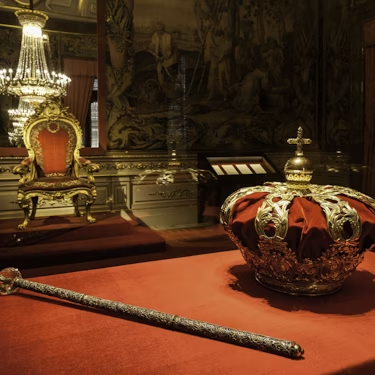More about: 13 Best Paintings at the Prado Museum
The Prado Museum is the spearhead of the art triangle formed by the Reina Sofía Museum, the Thyssen Museum, and the museum that is the subject of this article. Of all the things to see and do in Madrid, visiting this historic museum should be a priority for anyone visiting the Spanish capital.
Although its collection is not the most extensive, as it houses more than 27,000 pieces including paintings, sculptures, drawings, and prints, with more than 1,700 works on permanent display. Its historical value and variety make it one of the most important collections of paintings in the world. Famous artists such as Goya, Velázquez, Rubens, and Bosch have their home in the Prado.
You can spend an entire day in its galleries, but as that is not always possible, it is best to know in advance which are its main works, and that is why I am sharing these lists with the essential paintings you must see in the Prado Museum.
1. Saturn Devouring His Son, by Goya

We begin our review of the most important works in the Prado with one of its most relevant artists, Francisco de Goya, and one of his most striking works. Saturn Devouring His Son is part of a collection of 14 works known as the Black Paintings due to their dark colors and somber themes.
These characteristics are well represented in this particularly gloomy painting, which depicts the god Cronus, or Saturn, devouring one of his sons for fear that he would one day be dethroned.
It is a painting that astonishes viewers with the terror evoked by the god's gaze, the prominence and cruelty of the blood, and the contrast of colors used by Goya.
Details of interest
- Author: Francisco de Goya.
- Date: 1820-1823
- Location: Room 067 of the Prado.
2. The Naked Maja, by Goya

We move from the terror of Saturn devouring his son to the eroticism of Goya's The Naked Maja.
The painting was commissioned by Manuel Godoy, Prime Minister to King Charles IV, who had a particular taste for erotic art. Goya was chosen because at that time he was the leading painter among the nobility and one of the best in Europe.
Goya depicted a young woman lying naked as if she were Venus, but with unmistakable signs that the model was human. It was for this reason and certain details of her nudity that the painting was considered one of the first full-frontal nudes of a woman outside of mythology.
Godoy also commissioned another identical painting, but with the woman clothed, so that when the two paintings were superimposed, they simulated a nude. The great mystery of the painting is the identity of the maja, whom Goya kept anonymous.
Details of interest
- Author: Francisco de Goya.
- Date: 1795-1800
- Location: Room 038 of the Prado.
3. The Third of May 1808 in Madrid, by Goya

Napoleon dominated Europe during Goya's time and, taking advantage of his passage through Spain to conquer Portugal, decided to invade the country and crown his brother Joseph Bonaparte as king of Spain. On May 2, 1808, a popular uprising took place among the Spanish people, and on May 3, the French army retaliated by executing thousands of people.
This is what Goya depicts in one of his greatest works. The painting The Third of May 1808 is considered the first great contemporary work, as it has no similar precedents and gave rise to styles such as Romanticism.
The painting of the executions of May 3 inspired artists such as Picasso, who based his famous Guernica on this work.
Details of interest
- Author: Francisco de Goya
- Date: 1814
- Location: Room 064 of the Prado.
4. Las Meninas, by Diego Velázquez
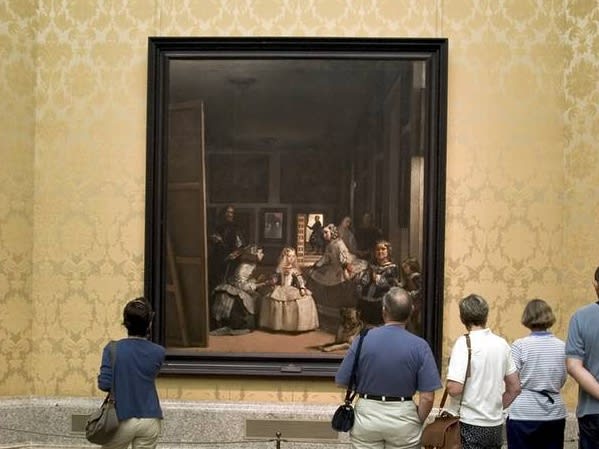
Las Meninas by Velázquez is undoubtedly the most representative and famous painting in the Prado Museum.
It is one of the largest canvases by the Sevillian painter, measuring over 3 meters wide and almost 3 meters high, and is considered his magnum opus. Rivers of ink have been spilled over the painting due to the mysteries surrounding it and the originality of its composition.
The painting depicts the Infanta Margarita, her meninas (ladies-in-waiting), other members of the court, and Velázquez himself; the kings, Philip IV and Mariana of Austria, are reflected in the mirror in the background. The artist depicts himself in the foreground as if it were the first selfie in history.
The complexity of the planes, the way he depicts the different figures, and countless other details make Las Meninas a masterpiece that is well worth the price of admission to the Prado Museum.
Details of interest
- Author: Diego Velázquez.
- Date: 1656.
- Location: Room 012 of the Prado.
5. The Crucifixion, by Juan de Flandes

Considered a masterpiece of Spanish-Flemish painting, The Crucifixion Panel was commissioned by Bishop Juan Rodríguez de Fonseca from Juan de Flandes, who painted it to form part of the main altarpiece of Palencia Cathedral.
The work was part of the altarpiece along with 10 other paintings by the same artist, who was unable to see them installed in the cathedral before his death. However, The Crucifixion is considered the best painting of the 10 due to the quality and detail of the scene.
Details of interest
- Author: Juan de Flandes.
- Date: 1509-1519.
- Location: Room 057 of the Prado.
6. The Three Graces, by Rubens

The painting The Three Graces depicts Aglaea, Thalia, and Euphrosyne, the daughters of Zeus, naked and embracing each other in a scene of apparent sensuality in accordance with the 17th-century canon of beauty.
The novel way of depicting these three goddesses made this painting by Rubens one of his best works, so much so that King Philip IV took it despite the fact that the artist had painted it for his own chambers.
- Author: Peter Paul Rubens.
- Date: 1630-1635
- Location: Room 029 of the Prado.
Details of interest
7. The Descent from the Cross, by Rogier Van der Weyden
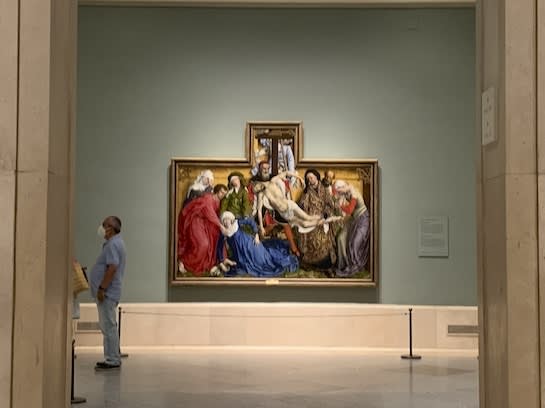
Rogier van der Weyden's masterpiece is a large panel with an added upper section that simulates a sculptural altarpiece; it is not a triptych. The colors and the artist's exquisite technique are surprising, considering that it is a work from the early 15th century.
Interestingly, The Descent from the Cross is in the Prado because King Philip II took a fancy to it and had it brought to Spain by ship. The ship was wrecked, but thanks to its good packaging, the work remained intact.
Details of interest
- Author: Rogier Van der Weyden
- Date: 1443
- Location: Room 058 of the Prado
8. The Garden of Earthly Delights triptych, by Hieronymus Bosch
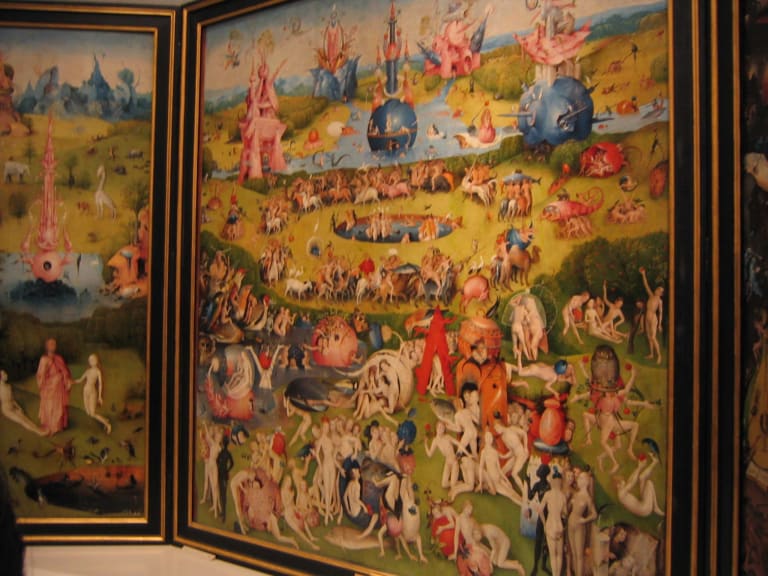
Bosch's magnum opus, known as The Garden of Earthly Delights, is a famous triptych depicting various scenes from the creation to the possible fate of humanity. When the triptych is closed, the scene of the creation is visible, and once opened, the work is divided into three parts.
The first two panels, on the left and in the center, depict paradise and the sin of Adam and Eve, while the scene on the right symbolizes the hell to which sin leads.
The painting's profound iconography, technique, colors, and complexity have made it one of the main attractions of the Prado Museum.
Details of interest
- Author: Hieronymus Bosch
- Date: 1500
- Location: Room 056A of the Prado
9. The Annunciation, by Fra Angelico

Fra Angelico's original name was Guido di Piero, and he was a Renaissance painter based in Florence. He was ordained as a priest, changed his name, and began to paint, with The Annunciation being one of his first and most controversial creations.
Fra Angelico's representation of The Annunciation was unusual and caused much controversy at the time. It was posthumously that his work was recognized as ahead of its time and his best work.
Details of interest
- Author: Guido di Piero
- Date: 1426
- Location: Room 056B of the Prado
10. The Surrender of Breda, by Diego Velázquez
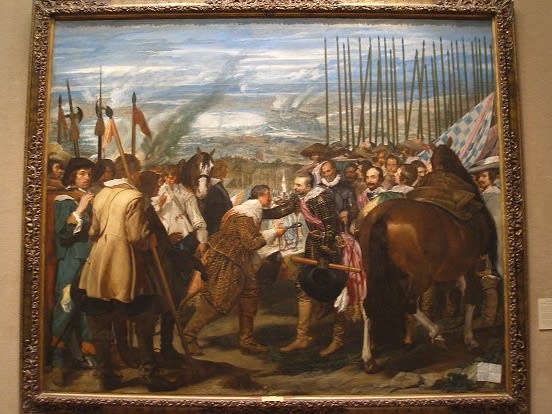
To understand this painting by the master Velázquez, you need to know its historical context. At the end of the 16th century, the Netherlands was embroiled in what is known as the Eighty Years' War, in which it sought independence from Spain. The city of Breda belonged to the Netherlands until King Philip IV decided to retake it.
The scene depicts the moment when, once conquered, the nobles surrendered their sovereignty to the Spanish. King Philip IV wanted to immortalize the moment, so he commissioned Velázquez to paint a large-scale version of The Surrender of Breda to decorate the Buen Retiro Palace.
Details of interest
- Author: Diego Velázquez
- Date: 1635
- Location: Room 009A of the Prado.
11. Self-portrait of Dürer

Dürer was a painter with a high opinion of himself. So much so that he used himself as a model to represent Jesus Christ. As a result of this self-esteem, he depicted himself wearing the finest clothes of the time and in very flattering colors. He sought perfection to such an extent that even the landscape seen from the window is inspired by beautiful Italy, while he was in Germany.
Aside from the artist's ego, Dürer's Self-Portrait is painted with remarkable technique that propelled him in his craft. A craft, incidentally, that was not considered befitting of nobles, which is a contradiction in the way Dürer painted himself.
Details of interest
- Author: Albrecht Dürer
- Date: 1498
- Location: Room 055B
12. The Cardinal, by Raphael
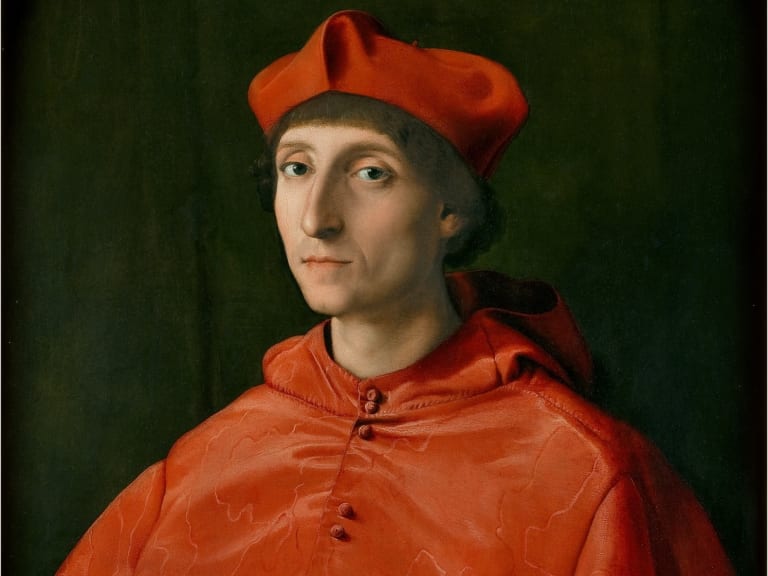
At first, the Portrait of the Cardinal went unnoticed until it became known that its author was Raphael, one of the greatest and most influential artists of the Italian Renaissance in the history of art.
Apart from Raphael's impeccable technique, the work aroused the interest of many because of its ambiguity, as the portrait could be attributed to many cardinals of the time.
It is not known for certain who the cardinal is who posed for the Italian artist, although there is a list of two or three probable names. The perspective of the portrait is very reminiscent of Leonardo Da Vinci's Mona Lisa, on display at the Louvre Museum in Paris.
Details of interest
- Author: Raphael
- Date: 1511
- Location: Room 049 of the Prado.
13. The Knight with His Hand on His Chest, by El Greco

El Greco is another of the star artists featured in the Prado collection. The museum houses several of his works , but the painting The Knight with his Hand on his Chest is particularly noteworthy The work depicts a knight in his thirties wearing typical 16th-century clothing.
Of all the portraits painted by the artist and exhibited in the Prado, this was one of the first to arrive at the museum and one of the most distinguished, due to the inclusion of an element such as the sword, which is rarely seen in this type of portrait.
It was this sword, together with the solemn gesture of the knight, that boosted his fame among the works of the painter who died in Toledo.
Details of interest
- Author: El Greco
- Date: 1580
- Location: Room 008B
















